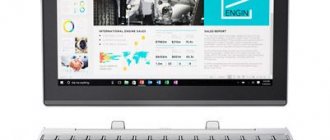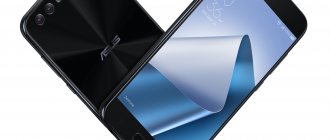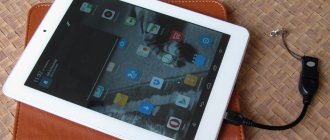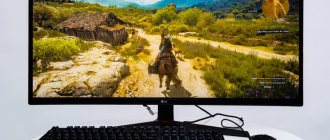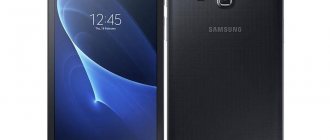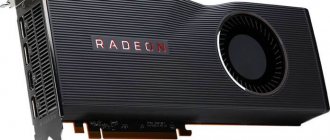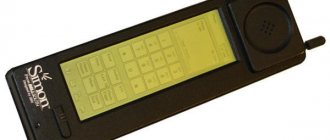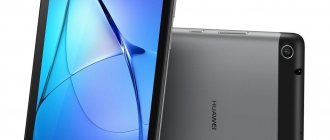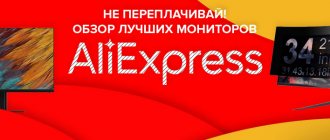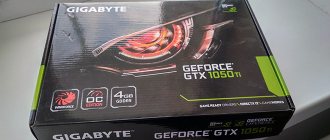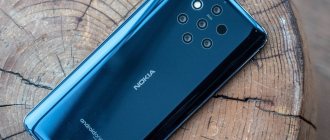15:07 2012-10-22 / Ivan Kushch / Test reviews of equipment
Tablets are still criticized for having an inconvenient virtual keyboard when it comes to typing large texts. Critics are adamant that the mechanical keyboard is the ideal. One of the first manufacturers to equip their tablets with an additional docking station with a full QWERTY keyboard was Asus. Now the most affordable model of such a tablet has not only a keyboard - an additional battery, but also a quad-core processor, an 8 megapixel camera, support for 3G, Wi-Fi and GPS. So it turns out that this is no longer a tablet, but some kind of laptop, albeit on Android 4. Meet Asus Transformer Pad 300TF.
A year and a half ago, Asus first introduced a tablet with an additionally connected mechanical keyboard. This was a response to the desire of some users who did not want to give up the advantage of using a regular keyboard. Another bonus was that the keyboard contained an additional battery. This doubled the tablet's performance. The market liked the idea. Of course, sales were not the greatest, but for a niche product they were quite successful. This is how a whole line of similar devices appeared.
The 2012 line includes the top-end Asus Transformer Prime tablet in a metal case and the more affordable Asus Transformer Pad 300TF. The latter is very similar to the top model, but is made not of metal, but of plastic, which has a positive impact on price and a negative impact on reliability. On the plus side, it has versions with 3G and LTE. This is good news. Everything else more or less remains the same: 4-core NVIDIA Tegra 3 platform, IPS screen, Android 4.0 and the like.
The main task for me personally during this testing was to find an answer to the question whether an Android tablet with an external keyboard can fully replace a compact laptop or netbook. Here's what I got.
Dimensions. Contents of delivery
Without a docking station, the Asus Transformer Pad 300 looks just like hundreds of other tablets. In all respects it is very similar to the Samsung Galaxy Tav 10.1. The dimensions of the device from Asus are 263x181x10 mm, and the weight is 635 grams (for comparison, the iPad new 2012 is 241.2x185.7x9.4 mm, weight is 662 grams). With the same touch screen diagonal as an Apple tablet, our hero is more rectangular and focused on working in a horizontal position. The location of the charger slot and the buttons on the sides indicate the same thing. It is comfortable to hold the tablet with two hands; this model is noticeably lighter in weight than the Acer Iconia Tab A500 and its successors.
It seems to me that the Asus Transformer Pad 300 will be most comfortable to use at home, or in the back seat of a car, on trains, planes or intercity buses, but not in minibuses, trams, subways, etc. The situation is similar with the keyboard unit. In general, the “Asus transformer” does not like crowds, give it large spaces. =)
The scope of delivery includes:
- Asus Transformer Pad 300
- Adapter for connecting the interface cable to the electrical network
- Interface cable with unique connector (microUSB does not fit)
- Stereo headset (3.5 mm Jack)
- Cloth cloth for screen
- Clip for opening the SIM card tray
- Instructions
⇡#Internal structure
Despite the fact that the manufacturer positions the ASUS Transformer Book T300 Chi precisely as a transformable laptop, and not as a tablet computer with additional capabilities, the design of its main unit still corresponds to the design of the tablet. And tablets, as a rule, have a one-piece case without the ability to independently replace components. The hero of our review was no exception. Probably, the official warranty center will be able to open the case of this tablet, but it is not possible to do this at home without damaging it. So replacing the battery on the ASUS Transformer Book T300 Chi will not be as easy as on an ultrabook.
Internal structure of the keyboard
As for the keyboard, disassembling its case is no more difficult than the case of any laptop. To do this, just unscrew all the screws from the bottom panel, after which the halves of the case can be separated. The central part houses a rechargeable battery that can be easily replaced. Nothing else can be replaced or added here.
Design, construction
Design in modern tablets is a relative thing. For the most part, they are similar to each other, like two peas in a pod: a rectangle with a touch screen. Transformer Pad 300 is one of these.
Unlike its more expensive brother Transformer Prime 201, this tablet has a plastic body. But the feel of this plastic seemed quite decent to me. It is very tough and durable. I didn’t drop it on purpose, but the impressions were extremely positive. Using plastic instead of aluminum made the tablet cheaper, but it didn’t make it any less stylish. At the same time, the device received a 3G module, which was essentially not present in the Asus Prime.
If we talk about details, the Transformer Pad 300 case is composed of several elements. First of all, this is the glossy surface of the screen - it is black, the side inserts are made of dark blue plastic (I had a dark blue version on the test).
The textured pattern on the back of the tablet is very similar to the texture of polished aluminum. I would like to note that traces of use are completely invisible on the back panel of the device. That's a plus. There are several body colors available on the market: dark blue, white and red.
On the front of the tablet you can see a 1.3-megapixel camera for video calls (web camera), a light sensor, a spatial location sensor, it controls the display of the picture (portrait or landscape) - they are in the center. Most of the device is occupied by a 10-inch touch screen. There are no buttons here, all control is carried out from the display.
The volume rocker is located on the left side. Here you can also see a miniHDMI connector, a slot for microSD cards, and a slot for a standard-size SIM card. On the right side there is a 3.5 mm port for a headset. The on/off button and profile change button can be found on the top left.
At the bottom end there is an interface connector for connecting to a computer or charger. There are also mounts for connecting to a docking station.
There is an Asus inscription on the back surface. At the top there is an 8 megapixel camera, although without a flash. The battery here is non-replaceable. You can only remove it if you completely disassemble the case using tools, but then you will lose the warranty.
I liked the build quality of the Transformer Pad 300. During the two weeks that I walked with the device, I did not feel any laxity or fragility. The tablet is assembled at the company's plant in China.
Design
ASUS Transformer Pad TF300 tablet is distinguished by its small thickness and weight, less than a centimeter and 630 grams, respectively. The front panel is covered with protective glass Sodaline Glass (a more affordable alternative to Gorilla Glass), the width of the frame is sufficient to comfortably hold the tablet in your palms.
Above the 10-inch IPS screen of the ASUS Transformer Pad TF300 there is a light sensor and a 1.2 megapixel camera. The back panel is designed in the style of the ASUS Zenbook line of ultrabooks - a pattern of concentric circles that are clearly visible to the touch. An 8 megapixel camera with autofocus without flash is integrated into the upper part of the panel; a slot for a single multimedia speaker is located on the left.
The thin rounded sides of the ASUS Transformer Pad TF300 are made of plastic to match the color of the case. At the bottom there are two holes for fixing in the docking station and a proprietary port that can be used both to connect to the dock and independently for charging and data transfer.
On the top you can find a miniature power button and a microphone, on the right is a standard audio output. And finally, on the left side there is a volume rocker, a micro-HDMI port and a card reader for MicroSD memory cards.
The docking station weighs 100 grams less than the tablet itself, which leads to some instability when assembled. The total weight of the ASUS Transformer Pad TF300 + docking station is 1150 grams. The locking mechanism is made of metal and looks quite reliable.
The ASUS Transformer Pad TF300 docking station is made of plastic with a smooth surface; it does not have a nice concentric texture like a tablet. The bottom is flat and has four rubber feet for user convenience. On the sides you can find a full-fledged USB port for working with peripherals, as well as a second SD card reader.
The working panel contains a full-fledged keyboard with a standard character-numeric block and Android OS-specific Home, Find, and Menu keys. We especially note the top row of service buttons, which allow you to adjust the sound volume, screen brightness, disable wireless modules, launch the browser, settings mode, etc.
A touchpad with a rocker key allows you to control the ASUS Transformer Pad TF300 in a style familiar to laptop users, but most importantly, the battery built into the docking station extends the battery life of the tablet by one and a half times.
Keyboard dock
The docking station looks like a classic netbook keyboard, without the screen, of course. However, a number of function keys are completely filled with special buttons. This includes “back”, Wi-Fi, brightness, browser, player, etc. In my observations, there is everything that is implemented in system notifications in Android OS itself. And it’s very convenient, everything is at hand.
Also, as in all transformers from ASUS, the keyboard is an additional source of energy (an additional battery is built-in). The docking station is made of the same plastic as the tablet itself. Thanks to the matte finish, fingerprints and traces of use are not visible.
The touchpad is very tiny, but standard, like in netbooks. If this is your first time using such touchpads, it will take a little time to get used to it.
On the left side of the dock there is a charging connector, and on the right there are two ports. One of them is for the SD card, and the other is for connecting external USB devices such as hard drives, cameras, flash drives, etc.
The tablet itself is attached to the docking station very simply. It is inserted into the cradle and secured with metal fasteners. In this form, the Asus Transformer Pad 300 looks like a real laptop or netbook.
The keyboard is attached to the tablet very securely. It is very tight and can only be straightened if the tablet is attached to the docking station.
In general, I really liked the format of a tablet + docking station with a keyboard. For those who like to write a lot, this is a very interesting option. This is both a tablet and a laptop, albeit limited by the capabilities of the Android operating system. According to the manufacturer, in this mode the device can work for up to 15 hours without recharging, which is undoubtedly a plus.
Many fans of the ten-inch Transformer Prime tablet from ASUS based on Android have decided not to rush into purchasing this top-end tablet in the hope that ASUS will soon release a less expensive modification. Their expectations were met in the form of the new 10.1-inch Transformer Pad TF300 tablet based on the Android 4.0.3 Ice Cream Sandwich operating system. In addition to the tablet, users can purchase a unique keyboard dock, which is a removable full keyboard with an auxiliary battery. The new product comes in three colors - Royal Blue (currently available), Torch Red and Iceberg White. Let's see why this model became cheaper than its older brother, and how the lack of additional frills affected the attractiveness of the new tablet.
Specifications and Hardware
This device is a tablet computer, but depending on your preferences, it can turn into a netbook with Wi-Fi connectivity. The keyboard unit in the Transformer Pad TF300 is reminiscent of the solution that was used in the Transformer Prime, and before that in the Eee Pad Transformer, and continues to please with similar usability and functionality.
Those who plan to play games using a mouse on this machine will not have much difficulty finding a compatible USB mouse that easily connects to the tablet's docking station thanks to the presence of a full-size USB port, and there is also a full-size SD card port.
Directly on the body of the device itself there is a slot for MicroSD cards, a MicroHDMI connector, a port for charging and synchronization, a power key, a volume control and a headphone jack. Despite the fact that the manufacturer limited itself to a standard headphone jack, this in no way affected the sound quality of regular media recordings and games.
The Transformer Pad TF300 tablet comes in two configurations that have different memory modules - the $379 model has 16 GB, and the $399 version has all 32 GB. Both models can be offered in three colors – Royal Blue, Iceberg White and Torch Red. The blue version was the first to go on sale, and the remaining two models are planned to be available by the beginning of June. The detachable keyboard comes separately and costs $149.
Thanks to this pricing policy and powerful advertising from ASUS and NVIDIA, we should expect the popularity of the Transformer line of tablets to rise to the level of the Galaxy Tab 10.1. And, although the appearance of new items on the Android tablet market creates a little confusion between the two similar transformers from ASUS, the difference in price is the key point in distinguishing them. Those who have not yet decided to buy the ASUS Transformer Prime now have the opportunity to purchase an Android tablet of no worse quality than the Prime, but at a more affordable price.
{ads1}
According to ASUS, the new model has a number of hardware upgrades compared to the Transformer TF101, in particular with regard to expanding photo and video capabilities. The presence of an 8-megapixel camera with a slightly modified interface, as well as the use of an F2.2 aperture, makes it possible to bring the shooting quality to the level of tablets of the same rank. It should also be noted that there is no flash, which creates some inconvenience when shooting in the dark.
Inside, the new tablet is equipped with a Bluetooth 3.0 module and 1 GB of RAM using the new DDR3 standard. The weight of the tablet without the keyboard unit is about 635 grams, and the complete set weighs about 1.2 kg. Measuring 263 x 180.8 x 9.9 inches, the Transformer Pad TF300 is slightly thicker than its predecessor, but otherwise has identical dimensions.
In addition to other external characteristics inherited from Transformer Prime, the new TF300 tablet also acquired its weight imbalance between the keyboard unit and the tablet itself. But, due to the fact that the body of the new product is made mainly of plastic, the difference in weight between the two halves is kept at a quite comfortable level. Many users believe that the body of the new model, made of an alloy of polycarbonate and plastic, is inferior in quality to the metal body of the Transformer Prime. Although, according to others, such weight loss has several advantages.
The displays of both tablets are based on the same IPS technology, the only difference being that the Transformer Prime is equipped with an IPS+ display, while the TF-300 tablet has a regular IPS screen. Thus, the Prime's display brightness is almost twice as bright as that of the TF-300, which becomes especially noticeable outdoors. This is another point due to which the developers managed to reduce the cost of the new model. Each of these minor technical simplifications makes this tablet less impressive than its predecessor. But it is also worth noting that the lower cost did not affect its main characteristics and, undoubtedly, the Transformer Pad TF300 is a product of the highest quality.
Software
The Transformer Pad TF300 software is almost completely similar to the latest updated version of the Transformer Prime firmware. Both devices run Android 4.0.3 operating system with a slightly modified user interface. ASUS developers have made only minor changes, giving the new model a touch of uniqueness, and basically the tablet runs on the standard Ice Cream Sandwich. It's safe to say that the Transformer Pad TF300's greatest strength is its software.
Like all computers running on the NVIDIA Tegra 3 chipset, the new product is equipped with a 4-core processor using 4-PLUS-1 technology. The principle of operation of this technology is that powerful 4 cores are used for tasks that require more energy, and a fifth low-frequency core is used for simpler tasks. Thanks to this technology, the energy consumption of devices running on the Tegra 3 chip is significantly saved, and their battery charge lasts for a long time.
The performance of a device with an NVIDIA Tegra 3 chip is most fully revealed in computer games. All games are taken from the Tegra Zone portal, which was specially created by NVIDIA for gaming applications optimized for multi-core Tegra 3. Although an endless number of games can be found in the Play Google App Store, Tegra Zone is the only place where it is guaranteed that all games will run smoothly on the new Transformer Pad TF300.
NVIDIA presents gaming as one of the best ways to experience the full power of its quad-core processors in the TF300. Game lovers will be able to enjoy the speed and high quality of Glowball, Guerilla Bob, Soulcraft THD (beta) and Temple Run. When comparing two identical games on the new TF300 tablet and its more expensive Prime predecessor, there are no differences in performance between the two devices.
It also deserves due attention to consider both powerful tasks from the most nooks and crannies of the software, and simpler ones - after all, Tegra 3 is able to easily cope with each of them. And to be convinced of this, just take a look at the series of tests presented below, and don’t forget to compare them with the Transformer Prime performance!
{ads1}
Camera
As noted above, this device has a built-in 8-megapixel camera with the ability to record video at 1080p resolution and an F2.2 aperture. The camera interface has changed slightly and is almost identical to the original Transformer Prime.
When comparing video files, as well as several pictures taken in different conditions using the rear camera of this tablet, it turns out that their quality is slightly worse than that of the previous model. The main reason for this is the lack of flash, as all pictures taken at night or in poor lighting had slightly blurred outlines.
Battery
Transformer Pad TF300, like all devices with a Tegra 3 chip, is able to consume battery energy very economically. Thanks to the presence of a fifth low-power core, the battery of the TF300 tablet has the ability to work offline for a fantastically long time, even without the bonus battery located on the additional keyboard. According to ASUS, the TF300 tablet is capable of continuous operation for 8.5 hours and just over 13 hours using the keyboard dock. Repeated tests have confirmed these indicators; for example, in active video streaming or continuous gaming mode, the tablet can last more than 7 hours, and with a keyboard unit, battery life is extended to 10-12 hours. These truly delightful test results once again highlight all the advantages of the power saving mode and the incredible capabilities of the fifth low-power core.
It should also be noted that the battery charge indicator turns on only if the tablet is not charged directly, but through the keyboard unit. Having two separate batteries combined in one device makes the Transformer Pad TF300 one powerful unit.
Conclusion
So, Transformer Pad TF300 is a more affordable version of the most powerful and modern Android tablet. Those characteristics that the developers had to sacrifice in order to reduce the cost of the new product are not significant for many users. The biggest disappointment is the lack of a flash, but for most consumers this is unlikely to be a deciding factor when buying a new tablet, since few use devices of this type as their main camera or video camera. Those users for whom this issue is important will most likely prefer to purchase the more expensive Transformer model, but with a flash.
All materials and build quality of the TF300 tablet are not satisfactory. Even the plastic body, which replaces the heavy metal of the previous model, is of high enough quality and can compete with the highest rank Android tablets. ASUS didn't just remake the Transformer Prime into a cheaper version, the company created a new tablet based on Android of the highest quality, but at a more reasonable price, and gave it the name ASUS Transformer Pad TF300.
Source Slashgear.com
Graphics capabilities
The tablet has a touch screen made using IPS screen technology, which provides extremely clear images, maximum viewing angles and energy savings. As for the dimensions, everything is standard here - 10.1 inches, the display is slightly elongated horizontally, glossy, which is why fingerprints are visible on it. For this reason, a special cleaning cloth was included in the kit.
The screen resolution is 1280x800, it displays 16 million colors. Thanks to the accelerometer, the screen can automatically change its orientation. The display has good color reproduction, brightness, contrast and viewing angles.
The tablet has three preset backlight modes: energy saving, balanced, normal. However, the screen does not behave very well in the sun. The fact is that the picture fades quite a bit and the information is not so easy to read. This is especially true when working in direct sunlight.
Functionality
The ASUS Transformer Book T100 transformable laptop is based on the new economical Intel Bay Trail-T platform, in particular, it uses a quad-core Intel Atom Z3740 processor with an operating frequency of 1.86 GHz. The integrated Intel HD Graphics core, which is a greatly simplified version of the Intel HD Graphics 4000 “Ivy Bridge” graphics, is responsible for graphics processing. Most of the time the processor operates at a frequency of about 500 MHz and only goes to maximum speed under load.
CPU
GPU
Memory
WEI
The typical TDP level is about 2 W, not exceeding 4 W at peak, which made it possible to do without an active cooling system. The amount of RAM is 2 GB and cannot be upgraded. As a result, the performance level of this system significantly exceeds that of netbooks and approaches the performance level of entry-class laptops, which is quite enough for casual use.
PCmark8
3Dmark
3Dmark11
The ASUS Transformer Book T100 uses a 32 or 64 GB eMMC module as data storage, while the volume actually available to the user will be about 16 GB for the first configuration and about 32 GB for the second. The difference between the two configurations is also that the 32 GB version has a separate 8 GB storage for storing system files. Note that it is quite easy to expand the storage capacity using MicroSD cards.
Battery Eater, classic mode
Battery Eater, reader mode
The built-in two-section 31 Wh battery lasted 5 hours 30 minutes under maximum load and 11 hours 40 minutes in read emulation mode - this is simply an excellent result for an x86 system running a full-fledged operating system. Finally, we note that the ASUS Transformer Book T100 transformable laptop is supplied to the domestic market complete with the Windows 8.1 operating system and the Office Home & Student 2013 office suite. Moreover, we are not talking about a trial version, which will stop working after the trial period, but about a full-fledged “office” that can be used on an ongoing basis.
Interface and navigation. Functionality
The Asus Transformer Pad 300 runs on the Android 4 operating system. We tested the device with software version 4.0.3. The software can be updated via a cellular network or Wi-Fi.
The main controls are located at the bottom of the display, inside its working area, and not on the body. This is, first of all, the status bar at the bottom left - menu, panel of running applications, switching between applications, widgets and on the right - date, time, messages, access to quick settings of the tablet and communication capabilities.
In standby mode, up to seven desktops are available to the user. By default, they have widgets for weather, contacts, Google search, news, etc. Each desktop can be customized. In the future, individual programs can be grouped by meaning, for example, photos, videos and YouTube on one screen, and a calendar and notes on another. At the same time, the access speed increases several times.
The menu can be accessed by clicking “Applications” (block of squares) in the upper right corner.
Long pressing on any application's shortcut will move it to the desktop (the specific desktop will be suggested). To remove a shortcut from the desktop, you need to do the opposite.
The tablet has all the standard tools for text and voice input of information, and on-screen QWERTY keyboards.
Internet and Google services
The main browser of the Asus Transformer Pad 300 is Chrome. It supports modern operating algorithms, which is what a progressive browser should do.
The device is fully integrated with Google services such as Gmail, Flick, Google Talk, Google Maps, YouTube and, of course, Google search.
Work tools include Google Calendar. It allows you to view events by date, time and action. The service is a high-quality planner-organizer, all in one. All events can be divided into groups with corresponding fields. All information is stored on a Google server; you just need to provide your account information.
Multimedia capabilities
The “Play Music” item is a music audio player. You can view and listen to audio tracks. The following file formats are supported: aac, .amr, .ogg, .m4a, .mid, mp3, .wav, .wma. The tablet can record audio files in .amr format.
There is support for Windows Media Audio 9. There is sorting by artists, albums, genres, composers.
The standard headset is included in the package. Thanks to the miniJack 3.5 mm jack, you can choose any headphones.
The “Film Studio” item displays videos made both by the device’s camera and downloaded from the Internet.
The communicator allows you to view files in the following formats: .3gp, .3g2, .mp4, .wmv with resolutions up to 1080p. The tablet supports all standard video codecs DivX and Xvid and the .mkv container. However, there are problems with playing the .mkv format in 720p resolution, and the video is stuttering.
A unique thematic browser for photos and graphics is the “Gallery” item. All files are divided into thematic folders. Full synchronization with the Google Picasa service is supported.
Installing new programs
New programs and other applications can be downloaded for free and installed from Google Play via the Internet directly from your phone. The appearance of the program is intuitive, there is a search for applications by criteria. All proposed utilities are divided into “Programs” and “Games”. Within each section there is also a breakdown into categories. Most of their software for Android is free.
Among the pre-installed programs that are not included in the standard package are: Polaris Office (office suite), Pulse News (an application for reading news channels), an application for reading newspapers and books in different languages.
In "Settings" each user can personalize the mobile phone interface. This menu item concentrates almost all setup actions: 3G, GPS, Wi-Fi, as well as data synchronization. In addition, settings for graphic themes, display design, installed applications, and much more are also available here.
Photo and video. Camera
Asus Transformer Pad 300 has an 8 megapixel camera without flash. Why does a tablet need a camera on the back surface? It is enough to have a front-facing web camera and that’s it. However, there is a camera.
The pictures come out very normal for this class of devices. I would say that this is the level of the iPad of the last generation at the time of the release of this material.
The device can record video in H.263/MPEG4 format with a resolution of 720x480, 640x480, 320x240 at a speed of 30 frames per second. Videos are of good quality, moving objects are not blurred.
Camera
The tablet has two cameras: a front camera with a 0.3 megapixel matrix, and a main one with a 2 megapixel matrix. The first is intended exclusively for video calls and does not have any special picture quality. But it’s not intended for that, although you can take pictures with it.
The external camera has a higher definition of 2 MP. There is no flash, and standard night shooting modes cannot fully replace it. It's a little frustrating. Based on the eminence of the company, we can initially assume that there will be a camera of at least 8 megapixels. But it was not there. Although you can take very high-quality pictures with a two-megapixel camera in good lighting.
Working with the docking station
You can work on your tablet without a docking station. When you connect a keyboard, the tablet turns into a convenient typewriter or gaming netbook. After all, other than typing or playing, you can’t do anything with the keyboard. There are no applications for drawing or programming yet. So, it makes sense to use a keyboard only if you need to type a lot of text, play with the keyboard and mouse, and also if you need to charge the battery.
Transformer 3 Pro T303UA – the fastest
The advantages of the Pro T303UA tablet book include the ability to separate the keyboard and high data processing speed.
The latter feature is provided by one of the most powerful Core i7 processors, 8 GB of RAM and 256 GB of solid-state drive.
The only feature that is not impressive is the not very powerful battery. However, even this will be enough for 6–8 hours of active work.
It can run modern gaming applications using integrated graphics.
And the screen resolution exceeds that of larger laptops with conventional, non-touch displays.
If desired, you can find options on sale with even better performance - 16 GB of RAM and up to 1000 GB SSD. But their cost will be noticeably higher.
Options:
- display: IPS, 12.6", 2880 x 1920;
- processor: Intel Core i7-6500U;
- memory: 8 GB;
- disk: SSD 256 GB;
- weight: 0.8 kg;
- video: Intel HD Graphics 520;
- battery: 4400 mAh;
- price: from 80,000 rub.
Transformer 3 Pro T303UA.
Performance and memory
The tablet is built on the NVIDIA Tegra 3 platform with a quad-core processor with a frequency of 1.4 GHz. The amount of RAM is 1 GB, about 750 MB is available for system operation. The hardware allows you to ideally work without hitches, even with several programs running in the background. The speed of the interfaces, as well as the loading of programs and utilities, fully corresponds to the requirements of the time. Nothing slows down anywhere.
As you know, the Android 4.x OS itself “decides” when an application should be closed and unloaded from memory. That is, when you close it yourself, the application continues to hang in RAM for some time. So, the Task Manager allows you to close unnecessary applications immediately, freeing up space in RAM.
To store files and other data, the tablet uses a built-in memory of 32.64 GB. It can be expanded using microSD memory cards.
Communication capabilities
The tablet can connect to a computer via Wi-Fi, Bluetooth 3.0 or an interface cable (version 2.1).
You can access the Internet from your tablet through a cellular operator’s network (in HSPA networks up to 14.4 Mbit/s) or via Wi-Fi (WLAN IEEE 802.11b/g/n). The device also supports wireless accessories and Bluetooth 2.1 headsets with EDR and A2DP, including wireless stereo headsets.
The Asus Transformer Pad 300 can act as a Wi-Fi hotspot that distributes 2G/3G Internet connections. To do this, enable the “Wi-Fi access point” option in the wireless interfaces menu.
Characteristics
In the ASUS Eee Pad lineup, the Transformer TF101 tablet is not the only device. There is also a modification of the TF101G with a 3G module, an Eee Pad Slider SL101 with a built-in slide-out keyboard, and a couple of representatives of the 12.1-inch Eee Slate - tablets based on Windows 7. However, we will compare the device under review with its direct competitor - the Samsung Galaxy Tab 10.1.
The characteristics of the TF101 are not very impressive. If you think about it, flagship smartphones are even better than the largest Google tablets. However, it is obvious that such a configuration is quite sufficient for comfortable work. Manufacturers did not put pressure on high processor clock speeds, preferring a balance between CPU frequency, graphics accelerator and number of cores. The NVIDIA Tegra 2 chip is quite suitable for these purposes. Its ARM component operates at 1 GHz and has two cores, and the ULP GeForce graphics card is considered one of the best on the smartphone and tablet market.
In terms of communication capabilities, both tablets are also very similar. They are equipped with Wi-Fi controllers (supporting 802.11n) and Bluetooth. However, the latter of the ASUS TF101 is less advanced - it is based on version 2.1, while the Galaxy Tab 10.1 has already “mastered” the faster version 3.0. There was no 3G module in our TF101.
The amount of RAM and permanent memory on tablets is the same. However, regarding the latter, options are possible. So there is a version of the TF101 with 32 GB of memory, and the Samsung device can be equipped with a 32 and 64 GB solid-state drive.
However, the TF101's possible lack of internal memory is more than compensated for by the presence of a microSD card slot, which can be supplemented with another SD card reader on the docking station. And don’t forget a couple of USB connectors on the dock to which you can connect external drives.
In terms of connectors, the ASUS tablet is also very good. The Galaxy Tab 10.1 has only a 3.5 mm audio jack, while the TF101 is distinguished by the presence of Mini HDMI and the already mentioned USB on the dock. Mini HDMI can be useful for giving a presentation or even watching a movie on a big screen on vacation or a business trip.
As for device screens, we wrote above about the difference between PLS and IPS technologies, and their resolution and diagonal are the same. It remains to mention the cameras. The front one turned out to be better in Samsung, and the rear one in ASUS. But, in our opinion, the difference in resolution in this case is not fundamental at all. Here you can easily get by with less – it’s unlikely that anyone will often use a tablet as a camera.
We wrote above about the advantages of an aluminum case. However, its disadvantage is more weight. Compared to the Galaxy Tab 10.1, the ASUS tablet weighs more than 100 grams more, which is noticeable. The docking station adds another 640 grams (almost the same as the TF101), for a total weight of 1.32 kg. Typically, 10.1-inch netbooks weigh less, although they are made of plastic. But this weight is comparable to a 13.3-inch MacBook Air or any equivalent. However, all these laptops are not equipped with a pair of batteries, which contribute a significant share of the weight.
What remains are the operating systems. Both tablets were initially available with Android 3.0, but Samsung still began mass shipping the Galaxy Tab 10.1 with Android 3.1, and ASUS is already offering an update to Android 3.2 on its website. The latter is installed very simply, which we will discuss below. In the meantime, let's see which tablet is faster at work.
Duration of work
The Asus Transformer Pad 300 has a 7000mAh Li-ion battery. In testing conditions, a fully charged battery was enough to browse the Internet for 10 hours via Wi-Fi or watch videos for 9 hours. When using the tablet for work purposes, charging will last for two days. These are very respectable indicators. With a lower load, you can achieve longer operating times. The battery charges in four hours.
An additional energy bonus comes from using a docking station. This is definitely a big plus. The operating time almost doubles.
ZenBook Flip UX360CA - the most reliable tablet book
The Flip UX360CA tablet book combines compactness and lightness with a large screen. The battery charge lasts for 12–14 hours.
A powerful processor and 8 GB of memory are enough to run many gaming applications, even modern ones.
Moreover, the video card, although integrated, belongs to the latest generation of integrated graphics processors.
A guarantee of the reliability of this computer is the testing that samples underwent before being put into mass production.
When used as a laptop, the number of openings and closings of the lid exceeded 20 thousand.
Additional reliability is provided by an effective cooling system and a 512 GB SSD drive, and high data transfer speeds are provided by 2 USB 3.0 ports.
Specifications:
- display: 13.3 inches, 3200 x 1800;
- processor: 2 cores, Intel Core M7-6Y75;
- RAM: 8 GB;
- disks: 512 GB SSD;
- video memory: integrated, allocated from RAM;
- weight: 1.3 kg;
- battery capacity: 4590 mAh;
- cost: from 52,000 rub.
ZenBook Flip UX360CA
Results
Asus Transformer Pad 300 is a rare tablet that differs from its competitors and its own kind. On the one hand, this is a classic Android smartphone, and on the other, a miniature laptop with basic functionality. The battery life and speed of the tablet deserve special mention. During the entire test, it never froze or overloaded. This is a good result.
I can recommend this device for purchase.
The main competitors include the Samsung Galaxy Tab 10.1, the Apple iPad 2012, and the affordable Acer Iconia Tab of the new generation. The price of the tablet from Asus is quite competitive.
For me personally, I definitely liked the Asus Transformer Pad 300 given my need for a mechanical keyboard. But there are a few “buts”. I really want to wait for the release of the Surface tablet from Microsoft, which also has a portable full-size keyboard. I'd like to see what it's like at work. Well, an update to Apple tablets is just around the corner. After this, you can weigh everything and make your choice.
Advantages:
- High quality build
- High speed
- Simplicity and convenience of the user interface
- Long battery life and docking station
Flaws:
- No phone calls allowed
- Non-standard interface connector
- The keyboard is used only for texts and in certain games
On the day of publication, the Asus Transformer Pad 300 32 GB tablet with Wi-Fi, 3G and a docking station could be purchased for 22,990 rubles. The Asus Transformer Pad 300 64 GB version with Wi-Fi, 3G and a docking station - for 27,990 rubles. Without a keyboard, the cost of the tablets is 14,990 and 16,990 rubles, respectively.
Phone number provided for testing.
Screen
The first generation of tablets based on Android 3.0 had the same resolution of 1280x800 pixels. This was required by the artificially imposed limitations of the system, and therefore most tablets automatically became potential competitors of the iPad. With the release of Android 3.2, the restriction was lifted, but 10.1-inch models, which include the ASUS TF101, did not change the screen resolution and are unlikely to change it (unless it is increased).
In general, 1280x800 for 10.1″ is pretty good. The picture turns out to be quite clear, working with websites is a pleasure, you can view large PDF documents, and conveniently work with text files and spreadsheets. What can we say - just recently, most laptops with a diagonal of up to 15.4″ were equipped with a screen with this resolution.
However, the advantages of the TF101 display do not end there. Another, no less important thing is the type of IPS matrix. It has long been known that this type provides the best viewing angles and color rendition. Confirmation of this is clearly visible from every pixel of the screen of the tablet in question. The display is really very good and there are no complaints about it. In our subjective opinion, it is even better than the screen of the Samsung Galaxy Tab 10.1. The latter is based on PLS technology, recently launched commercially by Samsung. In terms of its operating principles, it is very similar to IPS, but is approximately 15% cheaper to produce. However, PLS has a well-known disadvantage of IPS - the screen filled with black color gives off a strong purple tint. Moreover, IPS technology has practically gotten rid of this feature in the latest generation modifications, which also applies to the TF101.
In short, the screen of the ASUS tablet is wonderful and we had absolutely no complaints about it.
